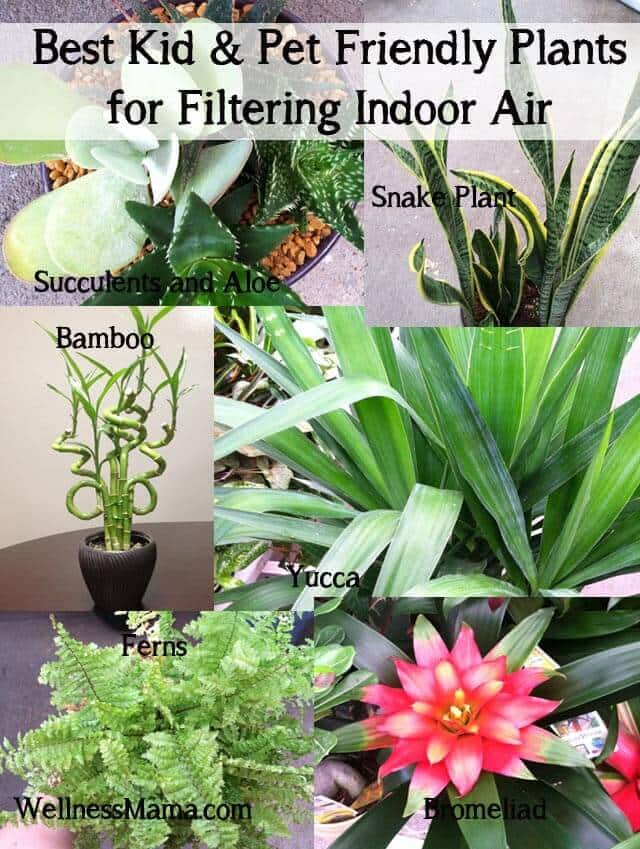I’ve heard it said that a person can go three weeks without food, three days without water (roughly) and three minutes without air (roughly). With those numbers, it seems that air quality should be an important consideration for health, as we proportionately consume more air than any other substance and as chemicals can be easily absorbed through the lungs.
Why Does Indoor Air Need Purifying?
Isn’t it outside air that’s harboring all the toxins? Well, there are plenty of toxins floating around outside thanks to pesticides and herbicides, vehicle fumes, and other industrial pollutants. Unfortunately, you’ll find a plethora of toxins in the air inside your own home as well.
Indoor air quality is affected by:
- cleaning products, especially laundry detergent and fabric softener, as laundry chemicals are the top indoor pollutant
- chemical flame retardants in furniture, mattresses, and children’s PJs
- formaldehyde found in gas stoves, garbage bags, paper towels and tissues, carpet backing, and some fabrics
- fragrances
- other toxins carried in on your clothes and shoes from outdoors
- electromagnetic frequencies (from computers, WiFi, and other electronics)
Simply opening your windows can go a long way, but what else can we do? I found one solution I really like! Plants!
Plants as Air Filters?
I did a lot of research to find the best type of air filters to use in our home. One of our children has allergies, and I wanted to find ways to reduce his allergy reactions in our house. I was ready to spend hundreds of dollars on a top-notch filter and the research I did showed that a much cheaper option might be the best. (We also currently use a basic filter to filter dust and large particles)
According to this article:
“In the late ’80s, NASA and the Associated Landscape Contractors of America studied houseplants as a way to purify the air in space facilities. They found several plants that filter out common volatile organic compounds (VOCs). Lucky for us the plants can also help clean indoor air on Earth, which is typically far more polluted than outdoor air. Other studies have since been published in the Journal of American Society of Horticultural Science, further proving the science.”
Since then, research has narrowed down which plants are the best at filtering indoor air and which plants filter which chemicals the best. Plants naturally absorb carbon dioxide and release oxygen, but certain plants also eliminate significant amounts of benzene, formaldehyde and/or trichloroethylene.
According to this article: “The recommendation of NASA is to use 15 to 18 good-sized houseplants in six- to eight-inch (203 mm) diameter containers in a 1,800-square-foot (170 m2) house.”
At our house, we don’t have indoor pets, but finding plants that were safe with kids around was a priority. I also needed plants that were relatively easy to take care of and pretty resilient.
Fortunately I’m mildly obsessed with plants (see my plant wall for proof!) and have tested and researched many over the years. These are my favorites and the ones that are best for indoor air.
The Best Houseplants to Purify Indoor Air
I’ve broken down the best houseplants to purify indoor air by their effectiveness, attractiveness, usefulness, and hardiness. This will help you decide which houseplants will best suit your needs.
Without further ado…

The Most Effective House Plants
These houseplants are the most effective at removing indoor air toxins and contaminants.
Bamboo Palm
Bamboo palms are effective at removing chemical contaminants from the air like formaldehyde and benzene. They also help to keep the air moist, which is especially helpful during winter months when heaters can produce overly dry indoor air.
Bamboo palms have a tropical appearance and, though green instead of the typical tan bamboo color, have the characteristic tall, skinny canes and fanned leaves.
Rubber Plant
The rubber plant is especially effective for removing formaldehyde from indoor air. It’s favored for its ease of growth, as well as its appearance, which features large, rubbery leaves.
The rubber plant can grow up to 8 feet tall in the proper conditions. This large ficus (ficus robusta) is bred for toughness, which means that it’s not only one of the most effective plants for purifying indoor air, but it’s sure to be hardy even in less than ideal conditions.
English Ivy
English ivy is most often seen growing as a covering in atriums and lobbies, but it makes a lovely feature if grown as a topiary. Like the rubber plant, English ivy is known for its ability to remove formaldehyde from the air.
English ivy needs lots of light to look its best, but does well when the temperature doesn’t get too hot. It is, however, very adaptable to its environment, as it will climb and spread over any surface given the chance.
Boston Fern
Ferns are one of the best-known varieties of houseplants, and the Boston fern is known for being the best plant for removing indoor air pollutants, and for adding humidity to indoor air.
While it is a champ at keeping indoor air clean, the Boston fern is somewhat finicky and requires an attentive caretaker. Without frequent watering and misting, the leaves will quickly turn brown and fall off.
Dwarf Date Palm
If you’re into tropical plants, the dwarf date palm is for you. It’s like an adorable mini palm tree that fits in your living room.
The dwarf date palm is one of the most effective palms for removing indoor air pollution, especially xylene, which is found in solvents and paint thinner. It’s also quite good at keeping the air moist and is fairly easy to grow.
The Most Beautiful Houseplants
It’s important to have houseplants that keep your air clean, but what about plants that are nice to look at? Here are the prettiest, best houseplants to purify indoor air.
Tulips
Tulips are truly lovely to look at. They come in a variety of colors, and also do a pretty good job of keeping the air clean, as they’ve been shown to be effective at eliminating formaldehyde, xylene, and ammonia from the air.
Azaleas
The dwarf azalea has been bred to remain indoors and bloom seasonally, and boasts big, pretty blooms. You can purchase it nearly any time of year, and with some care, it can bloom over and over. Of course, you’ll want to keep it blooming because it’s efficient at cleaning the air too.
Orchids
All varieties of orchids are quite pretty, but the level to which they filter the air varies. For instance, the dendrobium orchid features plain white blooms and removes alcohols, acetone, formaldehyde, and chloroform from the air. On the other hand, the more vibrant moth orchid, which features colorful blooms, including the well-known bright pink centered ones, is not as effective at purifying the air.
Wax Begonia
Begonias are a beautiful plant that are available in a number of vibrant colors, which can bloom year round given the right conditions. They also help to remove chemical vapors from the air.
Peacock Plant
With gorgeous purple and green hues, it’s easy to see where the peacock plant got its name. They can provide some help with keeping your air clean but are fairly finicky, requiring a lot of care and attention to growing conditions.
The Most Useful House Plants
These plants tend to be the most all-around useful to keep in your home. Although not necessarily known for their air-filtering ability, but I use these and have them in an indoor kitchen garden for culinary and medicinal uses.
Aloe Vera
Aloe vera is well known for its ability to soothe burned skin. Keeping it around allows you to use the fresh gel at a moment’s notice for scrapes and burns. It can also be used internally and can be squeezed into smoothies.
Aloe vera isn’t one of the best houseplants to purify indoor air, but it does have the unique ability to release oxygen and absorb carbon dioxide at night, making it a good choice for keeping in a bedroom.
Lavender
Lavender, with its earthy, sweet smell, has a soothing, calming effect. You can use it to make tea, tinctures, and even soaps and lotions. It’s also helpful for purifying the air by lowering carbon dioxide levels and cleansing bad smells.
Rosemary
Rosemary is both a culinary powerhouse as well as an air-purifying plant. Its antimicrobial properties make it a good choice for cleaning the air.
The Hardiest Indoor House Plants 
Have a black thumb? Then it’s important to choose hardy plants that will be forgiving to your lack of growing skills!
Palms
Palms come in lots of varieties, including the bamboo palm, which we mentioned above. They are both easy to grow and maintain, as well as resistant to pests.
Syngonium
An interesting-looking plant with large leaves, the syngonium is a pretty easy plant to grow. It is moderately effective at purifying the air and will be fairly forgiving to forgetfulness.
Philodendrons
A cousin to the syngonium, philodendrons are one of the best houseplants for purifying indoor air, plus they are rather hardy, requiring little upkeep.
Snake Plant
Snake plants have striking tall, pointy leaves, which would explain the name. There are many species, and while they’re not known as one of the best houseplants for purifying indoor air, like aloe vera, they cleanse the air at night by producing oxygen and removing carbon dioxide. Better yet, they’re easy to grow and resist pest infestation well.
And the Awards for Best Houseplants Go to …
If you want to choose just a few from the extensive list above, taking into consideration all above points, here are the winners across all categories:
Palms – Attractive, hardy, and one of the best plants for purifying the air.
Tulips – Very pretty, and quite useful at removing unwanted chemicals from the air.
Philodendrons – Hardy, excellent at purifying indoor air, and they come in lots of varieties, so you’re sure to find a pretty one.
Important Houseplant Caution
Some houseplants can be poisonous to children and pets. The above houseplants are the most effective at cleaning indoor air, but not all of them are safe for children and pets. Make sure to research and check out any plant for safety before bringing it into your home. Personally, I have quite a few houseplants but keep them where I know pets and children won’t try to eat them. Here is a partial list of plants to avoid if you have pets or children who are prone to eat them.
Where to Buy Air-Filtering Plants
If you’re wondering where to get these plants or if you will have to search every local greenhouse to find them, have no fear… Amazon to the rescue!
I order many of my houseplants on Amazon now (link here), especially when I need specific air-filtering kinds. (p.s. The cost is the same for you but helps support the blog at the same time, and I thank you!)
Filtering Indoor Air: My Line of Defense
Improving indoor air quality is a multi-step process. To improve the air quality in our home, we focus on the following steps:
- Opening the windows (if allergies allow)
- Reducing harmful chemicals by using natural cleaning and beauty products
- Keeping houseplants around the house – as many as possible 🙂
- Using a basic air filter to filter dust and large particles
- Spraying an indoor probiotic around the house to prevent mold and unhealthy bacteria
That’s our protocol! I’d love to hear what you do in your home!
Are you ready to fill your home with plants? Which air-purifying houseplants are your favorites?




Leave a Reply